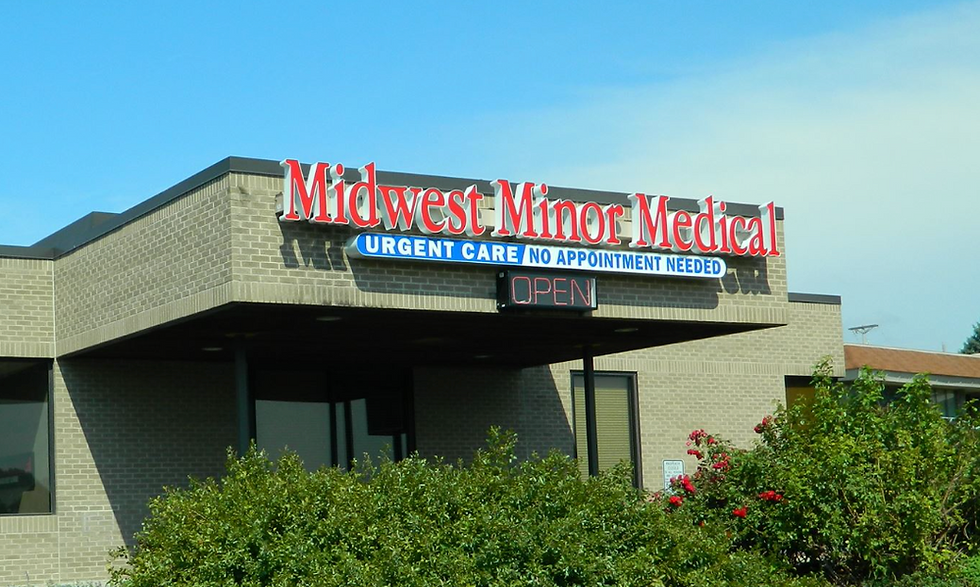What Does Strep Throat Look Like? Signs, Relief, and Care Options
- john22021
- Sep 13
- 5 min read

Strep throat is one of the most common infections that brings people to urgent care, especially during cold and flu season. While viruses often cause sore throats, strep throat is a bacterial infection that requires proper diagnosis and treatment to prevent complications. Knowing the strep throat symptoms to watch for can help you decide when to seek care. Midwest Minor Medical can guide you through the signs and treatment at our West Omaha clinic.
What Is Strep Throat?
Strep throat is an infection caused by the group A Streptococcus bacteria. It can be transmitted through contact with the mucus or sores from someone else. It can cause a sore and scratchy throat. Unlike viral sore throats, strep infections respond to antibiotics, which can reduce symptoms, prevent complications, and lower the risk of spreading it to others. Medicine that reduces pain and fever are also available to treat strep throat.
What Does Strep Throat Look Like?
Although strep throat can’t be diagnosed by just looking at it, there are a few visual distinctions that present with this type of infection:
Red, inflamed throat and tonsils
White patches or streaks of pus on the tonsils
Tiny red spots on the roof of the mouth
Swollen lymph nodes in the neck
In some cases of strep, a rash may develop on the neck and torso, eventually spreading to the arms and legs. The rash, commonly known as “scarlet fever,” has a characteristic sandpaper-like texture and is caused by capillary damage from toxins secreted by the strep bacteria.

In other instances, strep bacteria may enter a scratch or cut in the skin and cause an infection known as impetigo. Impetigo is extremely contagious and presents as pus-filled blisters that can form an itchy, painful crust in the affected area.
Impetigo is most common in very small children, aged 2-5. Scarlet fever occurs in children and adolescents, aged 5-15. Impetigo, which can also be caused by staph bacteria, is fairly common, while scarlet fever is quite rare.

Can You Get Strep Throat Without Tonsils?
Removing the tonsils has historically been a treatment for frequent strep infections. It is not a guaranteed fix, however, as the bacteria can still colonize other tissues of the mouth and throat. Without the tonsils, infections are rarer and the infection does tend to be milder.
Other Symptoms of Strep Throat
There are more symptoms of strep throat beyond the visual ones. Other symptoms of include:
Painful swallowing
Fever and chills
Headache
Fatigue or body aches
Loss of appetite
Abdominal pain
Nausea and vomiting
Strep Throat vs Tonsillitis
Tonsillitis is a general term that means “inflammation of the tonsils.” As such, it is actually a symptom of strep throat. However, tonsillitis is not always caused by strep.
Tonsillitis caused by strep is usually marked by sudden and severe sore throat. Tonsils are red and enlarged with telltale white patches or streaks. Again, swollen lymph nodes and fever are also often present. There is typically no cough or runny nose, as these symptoms are more often associated with a viral infection, such as the common cold.
Tonsillitis caused by another type of infection may have similar symptoms as strep but also be accompanied by congestion and a cough. Fever may or may not be present.
How Is Strep Diagnosed?
In addition to a physical exam of the mouth and neck, your healthcare provider will use one or both of the following methods to confirm strep throat:
Rapid Antigen Detection Test (RADT)
A long cotton swab is used to collect a sample from the back of the throat.
The swab is wiped across a small test strip that contains reagents that react a certain way in the presence of strep bacteria. It is similar to a pregnancy test: two lines appear if it is positive, one if it is negative for the group A strep bacteria.
Results are available in minutes. If it is positive, this is often enough to diagnose strep.
If negative, sometimes a follow-up throat culture is done. Rapid strep tests are sometimes not sensitive enough to detect strep bacteria, especially if it is very early in the infection. A culture can further rule out or confirm strep throat.
Throat Culture
Another swab is taken from the throat and tonsils.
The sample is placed in a culture medium to see if Group A Streptococcus grows.
This is considered more accurate than the rapid test, but takes 24-48 hours for results.

How Is Strep Throat Treated?
The primary treatment for strep throat is a course of antibiotics prescribed by a healthcare provider. Penicillin and amoxicillin are the typical antibiotics prescribed, but if you’re allergic to penicillin, there are alternative antibiotics. The antibiotics can be taken orally, either through a liquid or a pill, or they can be administered via a shot.
Over-the-counter pain relievers can help manage discomfort. Make sure to follow your provider's instructions when it comes to antibiotics. It is very important to take the full course, even if you are feeling much better.
How Can I Find Relief From Strep Throat At Home?
At-home care can help ease symptoms while antibiotics take effect:
Drink plenty of fluids to stay hydrated
Use warm salt water gargles (make sure it’s not too hot!)
Rest to support your immune system
Try throat lozenges or warm tea with honey for comfort (children over 1 can take a spoonful of honey to coat the throat for temporary relief)
Use a humidifier to keep the air moist and reduce throat irritation
Will Strep Throat Ever Go Away On Its Own?
Strep throat may improve slightly without treatment, but the bacterial infection rarely clears completely on its own. Without antibiotics, you remain contagious longer and are at higher risk for complications. Once you suspect you have strep throat, you should see a healthcare provider immediately.
How Long Is Strep Throat Contagious?
Strep throat is very contagious. According to the University of California, it can spread through the air when someone speaks, coughs, or sneezes. These particles can enter another person through breathing and/or touching a contaminated item and then touching your mouth or nose. Strep throat can also be transferred through touching the sores directly. Some individuals are asymptomatic and aren’t as contagious as those showing symptoms, but they can still be contagious.
With antibiotics, strep throat is usually no longer contagious after 24 hours. Without treatment, you may remain contagious for 2–3 weeks (or more), even if symptoms improve. Getting treatment quickly is important to reduce the spread throughout your home, workplace, or school.
When Should I Go To Urgent Care For Strep Throat?
Early testing and treatment ensure faster recovery and reduce the risk of spreading strep throat to others. We recommend visiting urgent care the moment you start experiencing symptoms of strep throat for faster diagnosis and treatment. Again, this helps prevent spreading the disease and also unnecessarily prolonging discomfort.
Urgent Care In West Omaha
If you or your child shows signs of strep throat, Midwest Minor Medical. Our urgent care in West Omaha offers rapid testing and treatment so you can feel better quickly. Walk in today or give us a call for convenient, fast, and compassionate care.




Comments